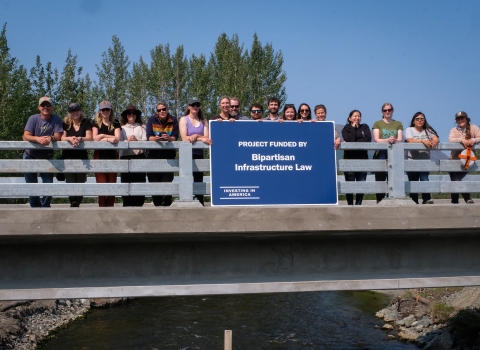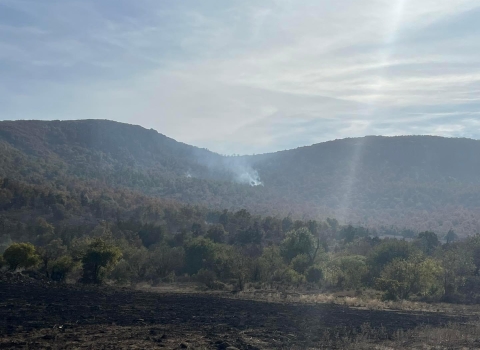ALASKA – Two fish passage fish passage
Fish passage is the ability of fish or other aquatic species to move freely throughout their life to find food, reproduce, and complete their natural migration cycles. Millions of barriers to fish passage across the country are fragmenting habitat and leading to species declines. The U.S. Fish and Wildlife Service's National Fish Passage Program is working to reconnect watersheds to benefit both wildlife and people.
Learn more about fish passage projects have broken ground that will restore free-flowing waters, allowing for enhanced salmon and trout migration and protect communities from flooding thanks to the nearly $2 million in funding from President Biden’s Bipartisan Infrastructure Law Bipartisan Infrastructure Law
The Bipartisan Infrastructure Law (BIL) is a once-in-a-generation investment in the nation’s infrastructure and economic competitiveness. We were directly appropriated $455 million over five years in BIL funds for programs related to the President’s America the Beautiful initiative.
Learn more about Bipartisan Infrastructure Law .
“Aquatic restoration projects funded by President Biden’s Bipartisan Infrastructure Law are important examples of how nature-based projects can enable ecosystems and communities to be more resilient to climate change climate change
Climate change includes both global warming driven by human-induced emissions of greenhouse gases and the resulting large-scale shifts in weather patterns. Though there have been previous periods of climatic change, since the mid-20th century humans have had an unprecedented impact on Earth's climate system and caused change on a global scale.
Learn more about climate change ,” said U.S. Fish and Wildlife Service Director Martha Williams. “In addition to providing benefits for fish and aquatic species, the National Fish Passage Program’s work to restore degraded and fragmented aquatic habitats decreases public safety hazards, improves infrastructure resilience, and creates jobs, stimulating the local economy.”
These are the first projects to break ground of 40 fish passage projects funded through the Bipartisan Infrastructure Law in fiscal year 2022. In total, the Law makes a $200 million commitment over the next five years to removing in-stream barriers, restoring rivers and conserving our nation’s aquatic resources under the National Fish Passage Program.
The first project to break ground, a bridge over the Little Tonsina River in the Valdez-Cordova Borough, will open more than 70 miles of salmon habitat with $1.3 million from the Infrastructure Law. This project will remove an undersized, double barrel culvert on the Little Tonsina River and support the creation of a two lane, 100-foot bridge spanning the channel and floodplain on Burma Pit Road near mile post 74.2 of the Richardson Highway. The new bridge will utilize the Service’s comprehensive Alaska design guidelines for building road-stream crossings that have fish and flood resiliency in mind.
During a storm in 2006, the site’s existing bridge and river culvert were overwhelmed and washed downstream, where they still sit in the riverbed today. Removing the old culvert and replacing the existing bridge will open up 70.4 miles pristine Coho and Chinook Salmon spawning and rearing habitat that lie above this barrier which eventually meet Alaska’s Copper River, one of the world’s most important sources of salmon.
The Little Tonsina River project is a partnership between the U.S. Fish and Wildlife Service, the Copper River Watershed Project, the Chugach Alaska Corporation, the State of Alaska, Bureau of Land Management, Alaska Sustainable Salmon Fund, NOAA Fisheries, The Denali Commission, Alyeska Pipeline Service Company. Read more
The second project, in Gustavus Alaska, will see a 60-foot glulam timber bridge installed over the Harry Hall Creek, a tributary of the Good River. The bridge will replace an existing culvert that has become too elevated, impeding fish passage – and is the last of eight other bridges to be set as part of a 10-year effort to reconnect the river’s entire watershed. This will complete the effort to provide unimpeded access to six miles of rearing habitat for juvenile coho salmon. In addition to salmon, Dolly Varden and coastal cutthroat trout use this creek.
The Gustavus project is a partnership between U.S. Fish and Wildlife Service, the City of Gustavus, Trout Unlimited, Alaska Sustainable Salmon Fund and National Fish and Wildlife Foundation. Read more




